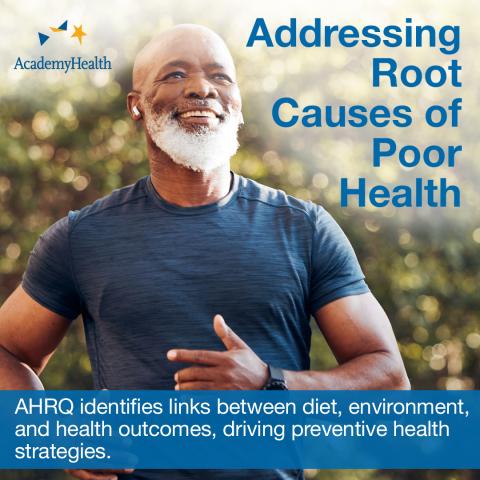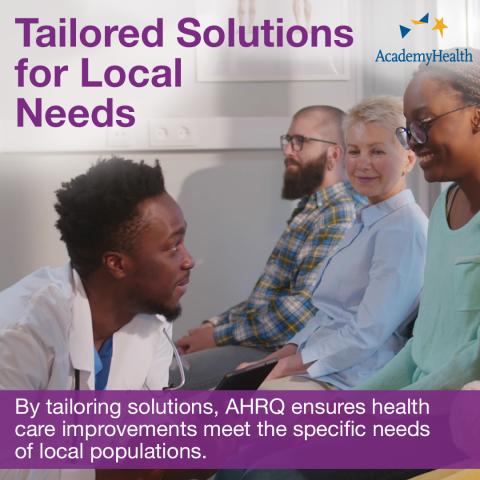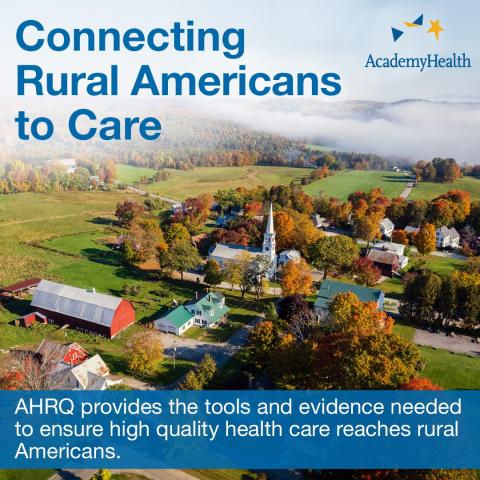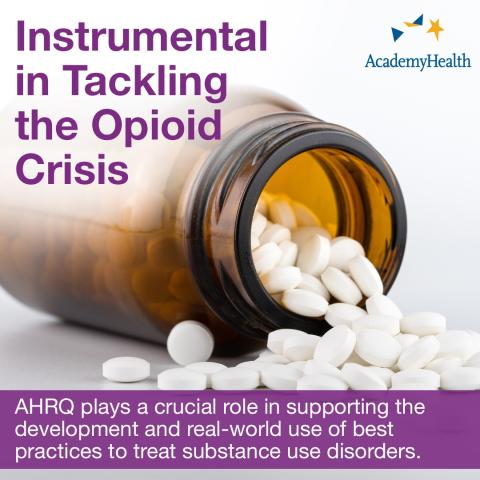The "Stand with AHRQ Toolkit" is designed to empower and equip our community with the necessary tools to advocate for collaborative reforms between the Administration, Congress and stakeholders involving the Agency for Healthcare Research and Quality (AHRQ). This comprehensive resource includes:
- Instructions for Contacting Congress
- Email Template
- Messaging Guidance
- Sample Social Media Posts
- Social Media Images
- Other Resources
The most impactful action you can take to support AHRQ is to directly contact your congressional representatives. Urge them to ensure that any proposed reforms involve collaboration with Congress and stakeholders, emphasizing the importance of AHRQ's role in enhancing health care quality, efficiency, and safety. Congress needs to hear from constituents like you about the importance of working together to preserve AHRQ’s vital contributions to national health.
Instructions for Contacting Congress
- Call your congressional office. Utilize your representatives' direct phone numbers instead of going through the U.S. Congress operator line. You can find these numbers on your congressional leader's website. Find your representative here. Find your senator here.
- Ask for the health staffer's email address. Once connected, request the contact information for the health policy staffer to ensure your message reaches the right person.
- Email the health staffer with messaging from below. Use the prepared messages to succinctly communicate the importance of collaboration between Congress and stakeholders to preserve AHRQ’s vital contributions to national health.
Template Email
Email Template
Subject: Ensure Congressional Oversight and Preserve AHRQ’s Vital Role Amid HHS Reforms
Dear [Representative’s Name],
I hope this message finds you well. My name is [your name], and I am writing from [City, State] to express my concerns regarding the recent announcement from the U.S. Department of Health and Human Services (HHS) which declared a significant restructuring initiative affecting the Agency for Healthcare Research and Quality (AHRQ).
As these changes unfold, it is crucial that Congress maintains strong input and oversight to ensure these reforms do not compromise AHRQ's statutorily mandated and unique focus on health services research. AHRQ plays an essential role in improving the safety, effectiveness, and affordability of health care, offering critical contributions such as:
- Reducing the burden of chronic diseases to improve care outcomes and quality
- Enhancing patient safety to prevent infections and adverse events
- Lowering health care costs, thereby increasing affordability and accessibility
To continue delivering these vital benefits, AHRQ must be adequately funded to sustain its impactful work that saves both money and lives. The proposed restructuring must not dilute or divert resources from AHRQ’s essential mission.
I urge you to ensure any reforms prioritize preserving AHRQ’s focus and provide sufficient funding, with Congress actively involved in oversight. Your leadership in protecting the integrity and mission of AHRQ during this transition is key.
Thank you for your dedication to safeguarding high-quality health care for all. I appreciate your attention to this pressing matter.
Sincerely,
[your name]
[City, State]
Messaging Guidance
| Focus Area | Key Message | Supporting Details |
| Cost Savings | AHRQ initiatives have led to significant financial savings in healthcare systems. |
|
| Patient Safety | AHRQ plays a vital role in enhancing patient safety across the nation, reducing serious safety events and preventing infections. |
|
| Chronic Diseases | AHRQ is a key player in reducing the burden of chronic diseases, providing evidence-based insights to improve health outcomes and care quality. |
|
| Rural Health | AHRQ is dedicated to addressing the unique healthcare challenges faced by rural Americans, making healthcare more accessible and equitable. |
|
| Opioid Crisis | AHRQ addresses the opioid crisis through research and initiatives aimed at reducing opioid-related deaths and improving treatment in rural areas. |
|
| Health Services Research | AHRQ supports essential HSR, which evaluates and improves healthcare delivery to make it safer, more effective, and cost-efficient. |
|
Sample Social Media Posts
Bluesky/X:
- 🚨I share @AcademyHealth’s concerns about theHHS plans to merge ASPE with AHRQ. AHRQ is vital for saving costs, boosting patient safety, and aiding rural health. Ensure reforms have Congressional oversight to preserve AHRQ’s role and funding. Contact your reps! #SaveAHRQ https://ow.ly/kwAW50Vq3Tl
- 🏥 AHRQ cuts healthcare costs, improves safety, tackles chronic diseases, and supports rural health. With HHS reorg plans, I join @AcademyHealth in demanding that Congress ensures oversight and keeps AHRQ's focus and funding intact. Contact your reps! #HealthForAll https://ow.ly/kwAW50Vq3Tl
- 📢 HHS's merger of ASPE and AHRQ risks AHRQ's vital initiatives in safety, cost-saving, and rural health. Join @AcademyHealth who is demanding Congress oversees reforms to protect AHRQ's mission and funds. Contact your reps now! #HealthAdvocacy https://ow.ly/kwAW50Vq3Tl
- 🌟 AHRQ saves costs and enhances care, impacting safety and rural health care. With HHS merging ASPE and AHRQ, join @AcademyHealth & urge Congress to safeguard AHRQ’s mission and funding. Reach out to reps today! #SupportAHRQ https://ow.ly/kwAW50Vq3Tl
LinkedIn/Facebook:
- Today, HHS announced a restructuring to merge ASPE and AHRQ under an Executive Order. AHRQ’s initiatives are vital to financial savings, patient safety improvement, chronic disease management, and rural health care access. It’s imperative these reforms include Congressional input to preserve AHRQ’s unique focus and secure its funding. Join me and AcademyHealth to push Congress to prioritize these principles and maintain AHRQ’s essential contributions to a safer, more effective, and cost-efficient health care system. #SupportAHRQ https://ow.ly/kwAW50Vq3Tl
- HHS's plan to merge ASPE with AHRQ underscores the need for Congressional oversight. AHRQ is vital for reducing costs, improving safety, managing chronic diseases, and supporting rural health care. It’s crucial to ensure AHRQ’s mandate is preserved, and it remains well-funded to continue these essential roles. I’m joining AcademyHealth to advocate for effective collaboration by contacting my representatives. Join me! #HealthAdvocacy #SupportAHRQ https://ow.ly/kwAW50Vq3Tl
- The merging of ASPE and AHRQ announced by HHS puts AHRQ’s essential initiatives at risk. AHRQ plays a critical role in enhancing patient safety, reducing costs, improving chronic disease outcomes, and addressing rural health care challenges. Join AcademyHealth and urge your representatives to ensure reforms include Congressional oversight and preserve AHRQ's funding and unique mission. #SupportAHRQ https://ow.ly/kwAW50Vq3Tl
Instagram:
- 🏥 Advocate for Transparent AHRQ Reforms 🏥
HHS announced plans to merge ASPE and AHRQ, threatening AHRQ’s strides in saving health care costs and enhancing patient safety. Join AcademyHealth & demand that these reforms include Congressional oversight, preserve AHRQ’s mission, and ensure funding. #SupportAHRQ https://ow.ly/kwAW50Vq3Tl - 🔍 Protect AHRQ’s Role in Health Innovation 🔍
With HHS merging ASPE and AHRQ, it’s vital to protect AHRQ's efforts in improving safety, managing chronic diseases, and aiding rural health care. Join AcademyHealth and demand Congressional involvement and robust funding. Connect with reps today! #SupportAHRQ https://ow.ly/kwAW50Vq3Tl - 🤝 Ensure Stakeholder-Inclusive AHRQ Reforms 🤝
HHS's decision to merge ASPE and AHRQ could impact AHRQ's essential contributions to health care improvements in cost, safety, and rural access. Join AcademyHealth and advocate for Congressional oversight and sufficient funding! #HealthAdvocacy https://ow.ly/kwAW50Vq3Tl
Social Media Images
Other Resources
- Letter to Secretary Robert F. Kennedy from Senator Richard Blumenthal and Representatives Donald S. Beyer Jr. and Jamie Raskin
- Friends of AHRQ Letter to Congress on FY26
- If you would like to support AcademyHealth’s ongoing efforts to advocate for AHRQ, please consider making a donation.
AcademyHealth Blog Posts
- Bridging the Gap: AHRQ’s Role in Rural Health Care Access Amid Hospital Closures
- The Actual Efficient Agency and Eliminator of Waste: Why AHRQ is a Smart Investment and Should Continue to be Funded Despite Reorganization
- More than a Funder: AHRQ’s Role as a Catalyst for Health System Transformation, Innovation, and Improvement
- AcademyHealth's Situation Report: AcademyHealth Decries Lack of Transparency in HHS Reorg and Provides Guidance to Affected Researchers
- AcademyHealth statement on the lack of transparency around the HHS reorganization announcement
- What's in a name? For the Agency for Healthcare Research and Quality, it’s Everything
- The Threat to Science Is Real. Here’s What Researchers Can Do.
- Patients, Providers, and Researchers Agree: The Agency for Health Research and Quality is Critically Important
- Secretary Kennedy: You Cannot Spell MAHA Without AHRQ
One-Pagers
AcademyHealth has developed one-pagers that are free to use in your advocacy and education efforts for AHRQ:
- What is Health Services Research?
- How does AHRQ support rural patients?
- What can AHRQ do about rural hospital closures?
- Health Services Research: Determining What Works and What Doesn’t in Healthcare
News Articles
- What’s Lost: Trump Whacks Tiny Agency That Works To Make the Nation’s Health Care Safer
- Trump administration begins mass cuts of federal health policy researchers
- RFK Jr. Plans 10,000 Job Cuts in Major Restructuring of Health Department
- Opinion | What Is DOGE's Real Goal?
- CDC, NIH and more health agencies brace for layoffs with DOGE and RFK Jr.'s restructuring. Here's what we know.
- HHS agency responsible for health care quality research threatened with mass layoffs
- Forbes: At Little-Known Health Agency, DOGE Ends Dream ‘To Make A Difference’
- POLITICO: HHS braces for a reorganization






